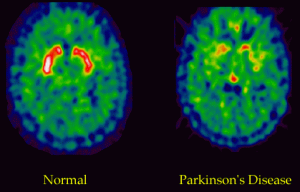Knocking Out Parkinson's Disease
Parkinson’s disease is one of the most infamous neurological disorders known to medicine and has afflicted many, including Muhammed Ali and Michael J. Fox. Described by it’s characteristic tremors and shaking, the disease induces loss of control of motor function as a result of neuronal death in dopamine-releasing (dopaminergic) neurons in a midbrain structure called the substantia nigra. In the pathology of Parkinson’s Disease, this localized population of dopaminergic neurons start to die, while other neurons in the substantia nigra and other local dopaminergic neurons remain healthy and functional. This has puzzled researchers extensively, but a recent letter to Nature provides some breakthroughs in understanding what is happening in these degenerative neurons.

Muhammed Ali and Michael J. Fox are two celebrities battling Parkinson's Disease.
Recent research into Parkinson’s suggests that the problems are localized to the mitochondria of the suspect neurons, leading to the conclusion that the disease is related to problems with metabolism. The mitochondria are the machines of cell metabolism and the stage for the Kreb’s Cycle and the Electron Transport Chain (ETC), which are the two major energy producing processes of the cell. The metabolism occurring in the mitochondria produces large amounts of adenosine triphosphate (ATP) which is used as energy currency in all cells of the body, and also lead to the production of water to be used elsewhere by the cell. Oxidative stress in the water producing portion of the metabolic pathway can lead to the production of oxygen free radicals, which are highly reactive as a result of a single free electron (free radicals have implications in other degenerative disorders and cancer). Scientists now suspect that these free radicals are contributing to the neurodegenerative consequences of Parkinson’s Disease.

Neuroimaging study showing the decreased neuronal activity in Parkinson's Disease.
In the Nature study, scientists tagged the mitochondria of the Parkinson’s suspect neurons with fluorescent protein that would allow them to observe oxidation states of the cells in rats. They found that Parkinson’s cells were in fact under a high level of oxidative stress and showed stress patterns at regular intervals, concluding that the cells function rhythmically when releasing dopamine. This rhythmic function is associated with ATP driven increases of calcium levels in the neurons, and the study suggests that this rhythmic calcium fluctuation is the instigator of the oxidative stress associated with Parkinson’s disease. In further experimentation, the researchers blocked these calcium influxes with drugs, which led to a decrease in Parkinson’s-like oxidative stress in mouse models of early-onset Parkinson’s disease. These drugs are known to be tolerated by humans well, and provide a legitimate option for medicinal therapy in the disease.
Oxidant stress evoked by pacemaking in dopaminergic neurons is attenuated by DJ-1 – Nature 2010
December 13, 2010
Parkinson disease generally seen in older age.Person feels nervous systems problems when he/she is affected by this disease.
June 12, 2011
Transgenic Mice has allowed researchers to observe experimentally the roles of genes in development, physiology and disease. Transgenic mice has become a real human pathology model and their use has dramatically increased for the past two decades. Medical devices companies have also succeeded in developing state-of-the-art miniature equipments adapted to mice enabling researchers to maximize their project study.Get a Quote Now! Save Time & Money!
January 9, 2012
Great Share! comfortable post, i certainly love this website, continue on it!